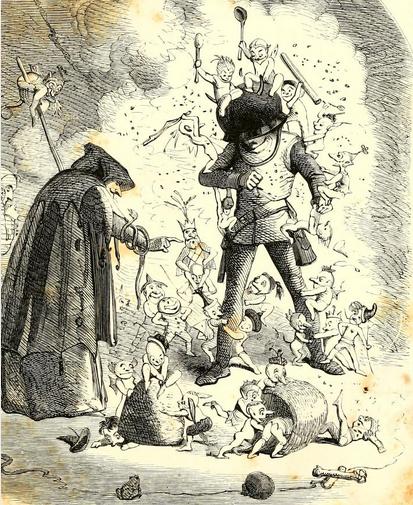Pixies (aka Pigseis, Pizkies and Piskies or Pigsies, Pizkies and Pigsies) are associated, above all, in their south-western heartlands with mischief. Men and women are pixy-led or piskey-led, which means that the pixies lead their victims off their paths. Victims are advised to turn a coin or turn a coat or jacket, socks or even a pocket inside out. Though sometimes the wanderer strays into a bog, which might point to a darker idea behind the legend: were victims originally drowned? Pixies also ride horses, donkeys and ponies at night, indeed, in many stories a farmer will discover platted or knotted manes the morning after on an exhausted animal. Pixies were also believed to have taken changelings as late as the mid nineteenth-century in Cornwall. Pixies are said, in some works, to be able to shape shift becoming ants, birds, hedgehogs and even weasels. Transformation into a weasel may be the result of linguistic confusion: in Cornish English a weasel was a ‘fairy’. Pixies are sometimes said to have been the souls of unbaptised children, a version of the idea that fairies are the dead. Pixies are described both as social and solitary fairies: sometimes they are in groups and sometimes alone.
Home region: Pixies are today thought of as the fairies of the south-west of England: Cornwall and Devon and to a lesser extent Dorset and Somerset. However, there are traces of pixy belief and pixy placenames and legends in the Welsh Marches and along the southern coast of England as far as Sussex.
Physical Description: Descriptions of pixies tend to break down into two different kinds. When pixies are social fairies and live in groups then they tend to be described much as other ‘fairies’: they are small and might wear green clothes and perhaps red hats. There seems also a tendency to be old: ‘the Piskey has seldom been seen in any other shape than that of a weird, wizzened-looking, little old man’. Solitary pixies tend to be bigger and if they are associated with houses or farms are often naked, hence the pixy clothes story. There is also a tendency, true of other fairy breeds too, for pixy to be equated or confused with Wil-O’-The-Wisp.
Earliest Attestation and Etymology: The origin of the word Pixy is much confused, not least because there is uncertainty about the proper form of the word. Pixies, first reference c. 1630, are also known as Pigseis, Pizkies and Piskies or Pigsies, Pizkies and Pigsies. The difference in spelling is fairly arbitrary (e.g. Pigsey vs Pigsie). The difference in pronunciation is above all regional: e.g. Piskeys are typically found in Cornwall and parts of west Devon. The word pixy or pixey has been preferred perhaps because they come from the more ‘cultured’ Devon or perhaps because the word ‘Piskey’ was a little too reminiscent of ‘piss’ to Victorian ears. But back to the original problem: where did piskey/pixy/pigsey come from? A pyske is the Swedish word for a small fairy: this would be an excellent candidate save for the fact that Norse influence in the south-west was slight. There may be a British-Celtic word lurking behind Pixy or Piskey but, if so, there is no obvious equivalent in Breton or Welsh. And the first occurrence of the word comes in the late sixteenth century. Given some medieval forms from the southern coast of England the correct etymology is almost certainly from Puca (Old English goblin).
Pixy Sighting: Widecome in the Moors.
Pixy Story: Pixy’s New Clothes.
Associated sayings: Pixy-lain or pixy-led [misled]; and Pixilated [OED ‘mildly elated’].
Popular Culture: Pixies first came to the attention of a wider reading public when Coleridge mentioned them in two of his early poems. In the second half of the nineteenth century pixies became truly famous thanks to the writing of Anna Eliza Bray. They subsequently began to appear in nineteenth-century fiction, often as more ‘earthy’ wingless versions of the effete and self-righteous Victorian fairy. They were frequently seen in Victorian theatre where children were cast as pixies. Pixies survived as second rate fairies through most of the twentieth-century. However, when Disney created Peter Pan, Tinkerbell was described as a fairy and pixy. This then tipped over into the later Disney Tinkerbell film series where Tinkerbell and her friends live in Pixy Hollow: though fairy is also used to describe her colleagues and friends.


